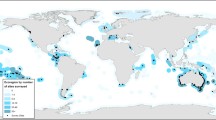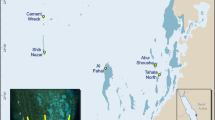Abstract
Principles of probability survey design were applied to guide large-scale sampling of populations of stony corals and associated benthic taxa in the Florida Keys coral reef ecosystem. The survey employed a two-stage stratified random sampling design that partitioned the 251-km2 domain by reef habitat types, geographic regions, and management zones. Estimates of the coefficient of variation (ratio of standard error to the mean) for stony coral population density and abundance ranged from 7% to 12% for four of six principal species. These levels of survey precision are among the highest reported for comparable surveys of marine species. Relatively precise estimates were also obtained for octocoral density, sponge frequency of occurrence, and benthic cover of algae and invertebrates. Probabilistic survey design techniques provided a robust framework for estimating population-level metrics and optimizing sampling efficiency.
Similar content being viewed by others
References
Aronson, R. B., Edmunds, P. J., Precht, W. F., Swanson, D. W., & Levitan, D. R. (1994). Large-scale, long-term monitoring of Caribbean coral reefs: Simple, quick, inexpensive techniques. Atoll Research Bulletin, 421, 1–19.
Ault, J. S., Diaz, G. A., Smith, S. G., Luo, J., & Serafy, J. E. (1999). An efficient sampling survey design to estimate pink shrimp population abundance in Biscayne Bay, Florida. North American Journal of Fisheries Management, 19, 696–712.
Ault, J. S., Bohnsack, J. A., Smith, S. G., & Luo, J. (2005). Towards sustainable multispecies fisheries in the Florida USA coral reef ecosystem. Bulletin of Marine Science, 76, 595–622.
Ault, J. S., Smith, S. G., Bohnsack, J. A., Luo, J., Harper, D. E., & McClellan, D. B. (2006). Building sustainable fisheries in Florida’s coral reef ecosystem: positive signs in the Dry Tortugas. Bulletin of Marine Science, 78, 633–654.
Bak, R. P. M., & Engel, M. S. (1979). Distribution, abundance and survival of juvenile hermatypic corals (Scleractinia) and the importance of life history strategies in the parent coral community. Marine Biology, 54, 341–352.
Beverton, R. J. H., & Holt, S. J. (1957). On the dynamics of exploited fish populations. Fishery Investigation Series II. Ministry of Agriculture Fisheries and Food, London, XIX, 1–533.
Bradbury, R. H., Loya, Y., Reichelt, R. E., & Williams, W. T. (1986). Patterns in the structural typology of benthic communities on two coral reefs of the central Great Barrier Reef. Coral Reefs, 4, 161–167.
Brown, B. E., & Howard, L. S. (1985). Assessing the effects of stress on reef corals. Advances in Marine Biology, 22, 1–63.
Burns, T. P. (1983). Hard coral distribution and cold-water disturbances in South Florida: Variation with depth and location. Coral Reefs, 4, 117–124.
Chiappone, M., Swanson, D. W., & Miller, S. L. (2002). Large-scale surveys on the Florida reef tract indicate poor recovery of the long-spined sea urchin Diadema antillarum. Coral Reefs, 21, 155–159.
Cochran, W. G. (1977). Sampling techniques (3rd ed.). New York: Wiley.
Connell, J. H. (1973). Population ecology of reef building corals. In O. A. Jones & R. Endean (Eds.), Biology and geology of coral reefs (pp. 205–245). New York: Academic.
Connolly, S. R., Hughes, T. P., Bellwood, D. R., & Karlson, R. H. (2005). Community structure of corals and reef fishes at multiple scales. Science, 309, 1363–1365.
Curry, G. L., & Feldman, R. M. (1987). Mathematical foundations of population dynamics. College Station, Texas: Texas A&M University Press.
Done, T. J. (1999). Coral community adaptability to environmental change at the scales of regions, reefs and reef zones. American Zoologist, 39, 66–79.
Dustan, P., & Halas, J. C. (1987). Changes in the reef-coral community of Carysfort Reef, Key Largo, Florida: 1974 to 1982. Coral Reefs, 6, 91–106.
FMRI (Florida Marine Research Institute) (1998). Benthic habitats of the Florida Keys. Technical Report TR-4. St. Petersburg, Florida: Florida Marine Research Institute.
Folmer, O., & Pennington, M. (2000). A statistical evaluation of the design and precision of the shrimp trawl survey off West Greenland. Fisheries Research, 49, 165–178.
Gardner, T. A., Cote, I. M., Gill, J. A., Grant, A., & Watkinson, A. R. (2003). Long-term region-wide declines in Caribbean corals. Science, 301, 958–960.
Gerstman, B. B. (2003). Epidemiology kept simple: An introduction to classic and modern epidemiology (2nd ed.). New York: Wiley-Liss.
Glynn, P. W. (1996) Coral reef bleaching: Facts, hypotheses, and implications. Global Change Biology, 2, 495–509.
Glynn, P. W., & Ault, J. S. (2000). A biogeographic analysis and review of the far eastern Pacific coral reef region. Coral Reefs, 19, 1–19.
Grigg, R. W., & Maragos, J. (1974). Recolonization of hermatypic coral on submerged lava flows in Hawaii. Ecology, 55, 387–395.
Gutierrez, A. P. (1996). Applied population ecology: A supply–demand approach. New York: Wiley.
Hairston, N. G. (1989). Ecological experiments: Purpose, design, and execution. Cambridge: Cambridge University Press.
Hansen, M. H., Hurwitz, W. N., & Madow, W. G. (1953). Sample survey methods and theory. New York: Wiley.
Hughes, T. P., Baird, A. H., Dinsdale, E. A., Moltschaniwskyj, N. A., Pratchett, M. S., & Tanner, J. E. (1999). Patterns of recruitment and abundance of corals along the Greater Barrier Reef. Nature, 397, 59–63.
Hughes, R. M., Paulson, S. G., & Stoddard, J. L. (2000). EMAP-surface waters: A multiassemblage, probability survey of ecological integrity in the U.S.A. Hydrobiologia, 422/423, 429–443.
Jaap, W. C. (1984). The ecology of the south Florida coral reefs: A community profile. FWS/OBS-82/08. Washington, D.C.: U.S. Fish and Wildlife Service, Division of Biological Services.
Knowlton, N. (2001). The future of coral reefs. Proceedings of the National Academy of Sciences USA, 98, 5419–5425.
Korn, E. L., & Graubard, B. I. (1999). Analysis of health surveys. New York: Wiley-Interscience.
Kramer, P. R., & Lang, J. C. (2003). The Atlantic and Gulf Rapid Reef Assessment (AGRRA) protocols: Former version 2.2. Atoll Research Bulletin, 496, 611–624.
Lang, J. (1973). Interspecific aggression by Scleractinian corals. 2. Why the race is not always to the swift. Bulletin of Marine Science, 23, 260–279.
Law, A. M., & Kelton, W. D. (2000). Simulation modeling and analysis (3rd ed.). New York: McGraw-Hill.
Levin, P. S., Fogarty, M. J., Murawski, S. A., & Fluharty, D. (2009). Integrated ecosystem assessments: Developing the scientific basis for ecosystem-based management of the ocean. PLoS Biology, 7(1), 23–28.
Lewis, J. B. (2004). Has random sampling been neglected in coral reef surveys? Coral Reefs, 23, 192–194.
Liddell, W. D., & Ohlhorst, S. L. (1987). Patterns of reef community structure, north Jamaica. Bulletin of Marine Science, 40, 311–329.
Lohr, S. L. (1999). Sampling: Design and analysis. Pacific Grove, California: Duxbury.
Loya, Y. (1972). Community structure and species diversity of hermatypic corals at Eliat, Red Sea. Marine Biology, 13, 100–123.
Marszalek, D. S., Babashoff, G., Noel, M. R., & Worley, D. R. (1977). Reef distribution in south Florida. Proceedings of the 3rd International Coral Reef Symposium, 2, 223–229.
Miller, S. L., Swanson, D. W., & Chiappone, M. (2002). Multiple spatial scale assessment of coral reef and hard-bottom community structure in the Florida Keys National Marine Sanctuary. Proceedings of the 9th International Coral Reef Symposium, 1, 69–77.
Miller, T. J., Skalski, J. R., & Ianelli, J. N. (2007). Optimizing a stratified sampling design when faced with multiple objectives. ICES Journal of Marine Science, 64, 97–109.
Montgomery, D. C. (2001). Design and analysis of experiments (5th ed.). New York: Wiley.
Murdoch, T. J. T., & Aronson, R. B. (1999). Scale-dependent spatial variability of coral assemblages along the Florida Reef Tract. Coral Reefs, 18, 341–351.
Nadon, M.-O., & Stirling, G. (2006). Field and simulation analyses of visual methods for sampling coral cover. Coral Reefs, 25, 177–185.
Newman, M. J. H., Paredes, G. A., Sala, E., & Jackson, J. B. C. (2006). Structure of Caribbean coral reef communities across a large gradient of fish biomass. Ecology Letters, 9, 1216–1227.
Porter, J. W., & Meier, O. W. (1992). Quantification of loss and change in Floridian reef coral populations. American Zoologist, 32, 625–640.
Porter, J. W., Kosmynin, V., Patterson, K. L., Porter, K. G., Jaap, W. C., Wheaton, J. L., et al. (2002). Detection of coral reef change by the Florida Keys monitoring project. In J. W. Porter & K. G. Porter (Eds.), The Everglades, Florida Bay, and coral reefs of the Florida Keys: An ecosystem sourcebook (pp. 749–769). Boca Raton, Florida: CRC.
Risk, M. J., & Risk, A. C. (1997). Reef surveys as an aid in management. Proceedings of the 8th International Coral Reef Symposium, 2, 1471–1474.
Santavy, D. L., Summers, J. K., Engle, V. D., & Harwell, L. C. (2005). The condition of coral reefs in south Florida (2000) using coral disease and bleaching as indicators. Environmental Monitoring and Assessment, 100, 129–152.
Särndal, C.-E., Swensson, B., & Wretman, J. (1992). Model assisted survey sampling. New York: Springer-Verlag.
Sen, A. R. (1964). Estimation of loss of crop from pests and diseases of tea from sample surveys. Biometrics, 20, 492–503.
Shinn, E. A., Hudson, J. H., Halley, R. B., & Lidz, B. (1977). Topographic control and accumulation rate of some Holocene coral reefs: south Florida and Dry Tortugas. Proceedings of the 3rd International Coral Reef Symposium, 2, 1–7.
Smith, S. J., & Gavaris, S. (1993). Improving the precision of abundance estimates of eastern Scotian Shelf Atlantic cod from bottom trawl surveys. North American Journal of Fisheries Management, 13, 35–47.
Smith, S. J., & Lundy, M. J. (2006). Improving the precision of design-based scallop drag surveys using adaptive allocation methods. Canadian Journal of Fisheries and Aquatic Sciences, 63, 1639–1646.
Smith, S. J., & Tremblay, M. J. (2003). Fishery-independent trap surveys of lobsters (Homarus americanus): Design considerations. Fisheries Research, 62, 65–75.
Smith, S. G., Ault, J. S., Bohnsack, J. A., Harper, D. E., Luo, J., & McClellan, D. B. (2011). Multispecies survey design for assessing reef-fish stocks, spatially-explicit management performance, and ecosystem condition. Fisheries Research doi:10.1016/j.fishres.2011.01.012.
Waddell, J. E., & Clarke, A. M. (Eds.) (2008). The state of coral reef ecosystems of the United States and Pacific Freely Associated States: 2008. Technical Memorandum NOS-NCCOS-73. Silver Spring, Maryland: U.S. Department of Commerce, National Oceanic and Atmospheric Administration.
Wright, B. E., Riemer, S. D., Brown, R. F., Ougzin, A. M., & Bucklin, K. A. (2007). Assessment of harbor seal predation on adult salmonids in a Pacific Northwest estuary. Ecological Applications, 17, 338–351.
Author information
Authors and Affiliations
Corresponding author
Rights and permissions
About this article
Cite this article
Smith, S.G., Swanson, D.W., Chiappone, M. et al. Probability sampling of stony coral populations in the Florida Keys. Environ Monit Assess 183, 121–138 (2011). https://doi.org/10.1007/s10661-011-1912-2
Received:
Accepted:
Published:
Issue Date:
DOI: https://doi.org/10.1007/s10661-011-1912-2




